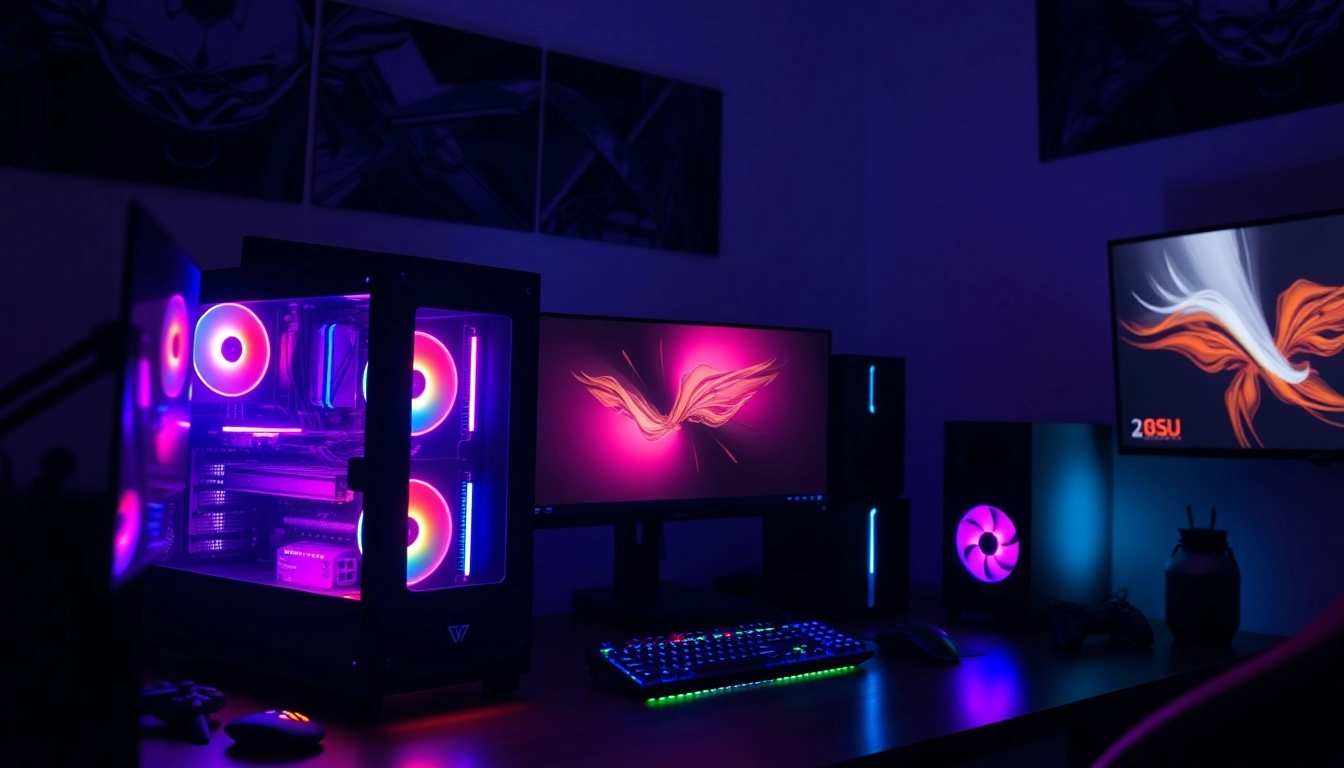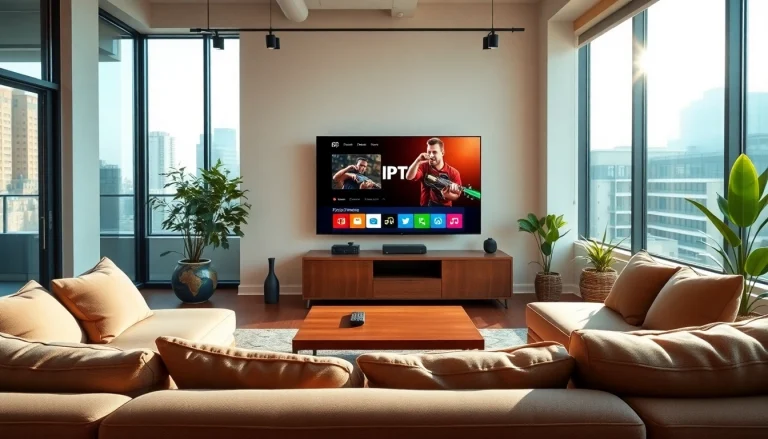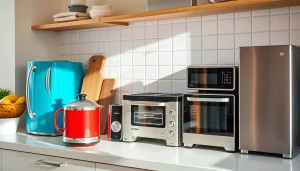Understanding the Importance of a Gaming PC Case
A gaming PC case might seem like just a protective shell for your components, but its role extends far beyond that. Choosing the right gaming pc case can influence your build’s performance, aesthetics, and functionality. A well-designed case can enhance cooling efficiency, facilitate better airflow, and provide easy access for upgrades. In this section, we will delve into why a quality gaming case is crucial and explore the key features to consider when selecting one.
Why Choose a Quality Gaming PC Case?
Investing in a quality gaming PC case is imperative for several reasons. One of the primary considerations is airflow. High-performance gaming components generate significant heat, and without adequate ventilation, your system may overheat, leading to throttling or potential damage. A quality case typically includes strategically placed fans and mesh panels to optimize airflow.
Furthermore, the build quality of a good gaming case ensures durability and longevity. Cheap or poorly designed cases may not adequately protect your hardware and can compromise your build’s structural integrity. Additionally, aesthetic features such as tempered glass panels and RGB lighting are often found in higher-end options, allowing gamers to build an impressive and visually appealing setup.
Key Features to Look For in a Gaming PC Case
When shopping for a gaming case, several key features should dictate your choice:
- Airflow and Cooling: Look for cases with multiple fan mounting options and large mesh sections for optimal airflow.
- Space and Size: Ensure the case can accommodate your components, including the motherboard size and the GPU’s length.
- Cable Management: A good case should allow for easy cable management, helping maintain a clean build and improving airflow.
- Expandability: Consider the number of drive bays and PCI slots for future upgrading potentials.
- Build Quality: Look for cases made of steel or high-quality materials that provide structural stability.
How a Gaming PC Case Affects Cooling and Performance
The impact of a PC case on cooling and performance cannot be overstated. A well-ventilated case will have a direct correlation with the cooling efficiency of your hardware. For instance, cases with pre-installed fans or support for liquid cooling solutions can dramatically reduce CPU and GPU temperatures, allowing the components to run at their optimal performance without thermal throttling.
Moreover, insufficient cooling may not only affect performance but can shorten the lifespan of your hardware. The right case will not only provide adequate cooling but will also help maintain stable internal temperatures, especially during long gaming sessions or intensive tasks.
Types of Gaming PC Cases
The market for gaming PC cases is diverse, and understanding the various types can guide you in making an informed decision:
Mid-Tower vs Full-Tower Gaming PC Cases
Mid-tower cases are the most popular choice among gamers, striking a balance between size, expandability, and usability. They often support ATX motherboards and provide enough space for multiple GPUs, ensuring that those looking for high performance can achieve it without needing a massive case. However, full-tower cases offer even more possibilities for expansion and cooling options, which may appeal to users looking for maximum performance or custom liquid cooling solutions.
If aesthetics are important to you, full-tower cases also tend to provide better opportunities for showcasing your components through transparent panels and RGB lighting. However, they do take up more physical space, which is a consideration for those with limited room.
Mini-ITX Cases for Compact Builds
Mini-ITX cases are perfect for users who prioritize compactness and portability. These cases are designed for smaller builds and still provide adequate cooling. However, users may have to compromise on expandability due to limited space for components. Despite this, many manufacturers have innovated in this space, enabling features like efficient airflow and cable management, which enhances the overall functionality of mini ITX builds. This makes them ideal for LAN party gaming or small office setups.
Specialty Cases: The Ultimate Customization
Specialty cases are designed for specific user needs and preferences, offering a unique blend of aesthetics and utility. Options include vertical GPU mounts, cases that support custom water cooling setups, or cases designed with specific themes in mind for enthusiasts who want their builds to stand out. Additionally, some manufacturers even allow users to completely customize their cases through modular designs, making it an attractive prospect for those interested in creating a truly unique setup.
Popular Brands and Models of Gaming PC Cases
With numerous brands available, navigating through the options can be daunting. However, some brands stand out for their innovation and quality.
Top Features of Corsair Gaming PC Cases
Corsair is well-regarded for producing high-quality gaming cases that cater to a wide range of users, from budget builders to high-end enthusiasts. Their cases often feature efficient airflow, customizable RGB lighting, and robust cable management options. Notable models include the Corsair 4000D Airflow, which is known for excellent cooling potential and build quality, and the iCUE 5000X, which provides a stunning aesthetic with its tempered glass panels and integrated RGB lighting.
NZXT’s Innovative Designs in Gaming PC Cases
NZXT is renowned for its stylish designs and user-friendly features. Their cases typically feature a clean, minimalist aesthetic with ample cable management options. The NZXT H510, for example, offers a sleek design alongside practical features, including a tempered glass side panel and great airflow options. Moreover, their CAM software provides users with customizable RGB lighting and fan control, enhancing the overall user experience.
Budget-Friendly Options for Gaming PC Cases
For those on a budget, there are plenty of options that don’t compromise on features. Brands like Cooler Master, Thermaltake, and Fractal Design offer several affordable models that still provide great airflow and enough space for essential components. The Cooler Master MasterBox Q300L is a popular choice for its portable size and functional design, making it great for first-time builders or users looking for a cost-effective setup without sacrificing quality.
Building Your PC: Case Compatibility
Understanding how to build your PC with case compatibility in mind is essential for a smooth assembly process. Here’s how to ensure compatibility:
Ensuring Your Components Fit in a Gaming PC Case
The first step is to check the specifications of both your case and components. Most cases will list supported motherboard sizes (such as ATX, microATX, or Mini-ITX) and GPU lengths. It’s essential to ensure that your motherboard and GPU can fit within the allotted space, as larger components may not fit in compact cases.
Additionally, check how many drives you plan to install; make sure the case has enough drive bays for your needs. Cases that do not accommodate your chosen components can lead to suboptimal performance or require tedious modifications to fit them in your build.
Motherboard and GPU Clearance in Gaming PC Cases
Motherboard clearance refers to the vertical space available between your GPU and the upper section of the case. High-end GPUs are often quite large, and if the case cannot accommodate the graphics card’s height, it can lead to issues. Additionally, GPU length should be checked, as some cases have limits on the maximum GPU size that can fit.
It’s also worth noting that some cases specifically feature a “GPU support bracket” to help eliminate sagging over time, which is particularly common with heavier graphics cards. This tool can be vital in maintaining the longevity and performance of your gaming PC setup.
Power Supply Considerations for Your Gaming PC Case
When choosing a case, the power supply unit (PSU) configuration should also be factored in. Many modern cases come with a dedicated PSU shroud to hide cables for a cleaner look. Ensuring the case can handle your PSU’s size—whether it’s a standard ATX, SFX, or another form factor—is crucial for maintaining a tidy build. Additionally, verify the case’s airflow design around the PSU, ensuring it does not become a hot spot within your build.
Maintenance Tips for Your Gaming PC Case
Regular maintenance of your gaming PC case ensures that it continues functioning optimally over time. Here are some useful maintenance tips to consider:
Cleaning and Upkeeping Your Gaming PC Case
Dust accumulation can severely impact airflow and cooling efficiency. It’s recommended to clean your case every few months. Start by unplugging your system and using a microfiber cloth to wipe down the exterior. For the interior, use compressed air to blow out dust from components and fans. Always ensure that no moisture remains, and take care around sensitive components like the motherboard and CPU.
Importance of Cable Management in Gaming PC Cases
Proper cable management not only creates a cleaner look but significantly enhances airflow within your case. Use zip ties or Velcro straps to bundle cables together and route cables behind the motherboard or through designated cable management holes. A tidy interior maximizes airflow, thereby improving cooling and overall performance.
Upgrading Your Gaming PC Case: When and Why
Upgrading your gaming case can become necessary when your needs change—be it a desire for better cooling, more space, or aesthetic appeal. Signs that it may be time for an upgrade include overheating components, difficulty in managing cables, or if you’ve simply outgrown your current case. Newer models often come with better airflow designs, improved aesthetics, and more features that can further enhance your gaming experience. Additionally, if you are planning to upgrade critical components, ensuring they fit within a more spacious case can prevent future issues.








